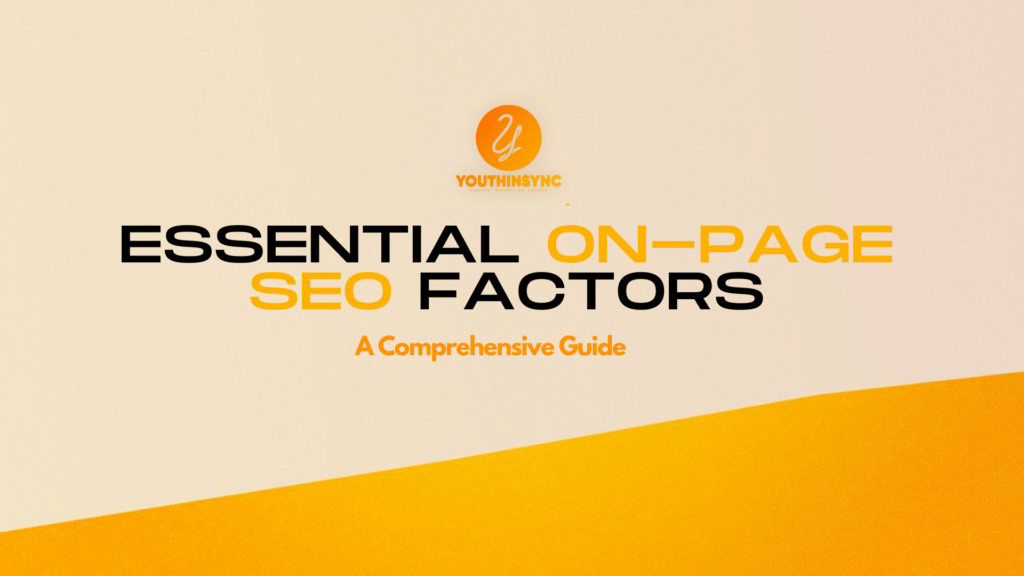Introduction
In today’s digital landscape, Search Engine Optimization (SEO) plays a crucial role in ensuring that your website stands out in a crowded online space. While off-page SEO, such as backlinks and social signals, is vital, on-page SEO is equally important. On-page SEO involves optimizing various elements on your website to make it more attractive to search engines and users alike.
This comprehensive guide will walk you through the essential on-page SEO factors that can help boost your website’s search engine rankings. By the end of this guide, you will have a deeper understanding of how to optimize your site for better visibility, higher rankings, and increased organic traffic.
What is On-Page SEO?
On-page SEO refers to the practice of optimizing individual web pages to rank higher and earn more relevant traffic in search engines. This type of SEO focuses on both the content and the HTML source code of a page, as opposed to off-page SEO, which involves external signals like backlinks.
Difference Between On-Page and Off-Page SEO
While on-page SEO involves optimizing elements within your website, off-page SEO deals with factors outside of your website, such as backlinks from other sites and social media signals. Both are crucial for a successful SEO strategy, but on-page SEO lays the foundation that supports off-page efforts.
Why On-Page SEO is Crucial for Search Engine Rankings
On-page SEO is essential because it helps search engines understand the content of your web pages. When your pages are well-optimized, search engines like Google can easily crawl, index, and rank them appropriately. This increases the chances of your content appearing at the top of search results, leading to higher organic traffic and better visibility.
Essential On-Page SEO Factors
Title Tags
Importance of Title Tags
The title tag is one of the most critical on-page SEO factors. It appears as the clickable headline in search engine results and is the first impression users have of your page. A well-crafted title tag can significantly impact your click-through rate (CTR).
Best Practices for Writing Effective Title Tags
- Include Keywords: Place your primary keyword at the beginning of the title tag.
- Keep it Concise: Aim for a title tag length of 50-60 characters.
- Make it Descriptive: Clearly describe the content of the page.
- Use Power Words: Words like “Guide,” “Tips,” or “Best” can attract clicks.
Meta Descriptions
Role of Meta Descriptions in SEO
Meta descriptions are brief summaries that appear under the title tag in search engine results. While they don’t directly affect rankings, they influence CTR, which can indirectly impact your SEO performance.
How to Craft Compelling Meta Descriptions
- Incorporate Keywords: Include relevant keywords naturally.
- Be Persuasive: Write in a way that entices users to click.
- Limit Length: Keep meta descriptions between 150-160 characters.
- Provide a Clear Benefit: Highlight what users will gain by visiting the page.
Header Tags (H1, H2, H3, etc.)
Importance of Proper Header Tag Structure
Header tags (H1, H2, H3, etc.) help organize your content and make it easier for both users and search engines to understand the structure of your page. The H1 tag is typically used for the main title, while H2 and H3 tags are used for subheadings.
Tips for Using Header Tags Effectively
- Use One H1 Tag: This should be the main title of the page.
- Incorporate Keywords: Include primary and secondary keywords in your headers.
- Maintain a Logical Hierarchy: Use H2 for main sections and H3 for subsections.
- Improve Readability: Break down content into digestible sections with headers.
URL Structure
SEO-Friendly URL Structures
The structure of your URLs can impact both user experience and SEO. A clean, descriptive URL can help search engines and users understand the content of your page.
Importance of Keywords in URLs
- Include Keywords: Use relevant keywords in your URLs to boost visibility.
- Keep it Simple: Avoid using unnecessary words or characters.
- Use Hyphens: Separate words with hyphens, not underscores.
- Avoid Dynamic Parameters: Use static URLs whenever possible.
Keyword Optimization
Importance of Keyword Placement
Keyword optimization involves strategically placing your target keywords throughout your content. However, keyword stuffing can lead to penalties, so it’s essential to use keywords naturally.
Tips for Avoiding Keyword Stuffing
- Use Synonyms and LSI Keywords: Incorporate related terms to avoid repetition.
- Focus on User Intent: Write content that satisfies the user’s search intent.
- Maintain a Natural Flow: Ensure that your content reads naturally, without forced keyword placement.
Content Quality
E-E-A-T and Its Role in Content
Google’s E-E-A-T guidelines emphasize the importance of high-quality content. Experience, Expertise, Authoritativeness, and Trustworthiness are critical factors in determining the value of your content.
Importance of Unique, Valuable Content
- Originality: Ensure your content is unique and not duplicated from other sources.
- Depth: Provide comprehensive information that covers the topic thoroughly.
- Accuracy: Verify facts and figures to maintain credibility.
- User Experience: Create content that is easy to read, visually appealing, and engaging.
Internal Linking
Benefits of Internal Linking for SEO
Internal linking helps distribute link equity across your site and improves the crawlability of your pages. It also enhances user experience by guiding visitors to relevant content.
Best Practices for Internal Linking
- Use Descriptive Anchor Text: Choose anchor text that clearly indicates the linked page’s content.
- Link to Relevant Content: Ensure that the linked pages are related to the current page.
- Avoid Over-Linking: Don’t overdo it; keep internal links relevant and useful.
- Regularly Update Links: Ensure that internal links are up-to-date and not broken.
Image Optimization
Importance of Alt Text and Image File Names
Image optimization is often overlooked but plays a vital role in SEO. Properly optimized images can improve your page’s load speed and accessibility.
Tips for Optimizing Images for SEO
- Use Descriptive File Names: Name your image files with relevant keywords.
- Include Alt Text: Write alt text that accurately describes the image content.
- Compress Images: Reduce file sizes without compromising quality to improve page speed.
- Choose the Right Format: Use formats like JPEG for photographs and PNG for images with transparency.
Mobile Responsiveness
Impact of Mobile-Friendliness on SEO
With the increasing use of mobile devices, having a mobile-responsive website is crucial for SEO. Google prioritizes mobile-friendly websites in its search results.
Best Practices for Ensuring a Mobile-Responsive Design
- Use a Responsive Design: Ensure your website adapts to different screen sizes.
- Optimize for Touch: Make sure buttons and links are easy to tap on mobile devices.
- Improve Load Times: Optimize images and use lazy loading to reduce load times on mobile.
- Test Regularly: Use tools like Google’s Mobile-Friendly Test to check your site’s mobile compatibility.
Page Speed Optimization
Why Page Speed Matters
Page speed is a critical ranking factor. A fast-loading website provides a better user experience and reduces bounce rates.
Techniques to Improve Page Loading Times
- Minimize HTTP Requests: Reduce the number of elements on your page to speed up loading.
- Use a Content Delivery Network (CDN): Distribute your content across various servers to improve load times.
- Enable Browser Caching: Allow browsers to store some of your site’s data locally to speed up future visits.
- Optimize JavaScript and CSS: Minify and compress your code to reduce load times.
Advanced On-Page SEO Techniques
Schema Markup
What is Schema Markup?
Schema markup is a form of microdata that helps search engines understand the content of your pages better. It enhances your listings in search results by providing additional information like ratings, reviews, and event details.
How to Use Schema Markup to Enhance SEO
- Identify Relevant Schema Types: Choose the schema that best suits your content (e.g., Article, Product, Recipe).
- Implement Correctly: Use tools like Google’s Structured Data Markup Helper to generate schema code.
- Test and Validate: Use Google’s Rich Results Test to ensure your schema is implemented correctly.
Optimizing for Featured Snippets
Understanding Featured Snippets
Featured snippets are concise answers to search queries that appear at the top of Google’s search results. Optimizing for featured snippets can significantly increase your visibility.
How to Optimize Content to Appear in Featured Snippets
- Answer Questions Directly: Write concise, clear answers to common questions.
- Use Bullet Points and Numbered Lists: These formats are often used in featured snippets.
- Structure Your Content: Organize your content with headers and subheaders to make it easier for search engines to extract information.
- Target Long-Tail Keywords: Focus on keywords that are more likely to trigger featured snippets.
Voice Search Optimization
The Rise of Voice Search
Voice search is becoming increasingly popular, with more users relying on virtual assistants like Siri and Google Assistant to find information.
Tips for Optimizing Content for Voice Search
- Focus on Natural Language: Write content that mimics how people speak.
- Answer Questions: Optimize for question-based queries, which are common in voice search.
- Target Long-Tail Keywords: Voice searches often use longer, more specific phrases.
- Improve Page Speed: Fast-loading pages are more likely to be featured in voice search results.
Common On-Page SEO Mistakes to Avoid
Even with the best intentions, it’s easy to make mistakes in your on-page SEO strategy. Here are some common pitfalls and how to avoid them:
- Keyword Stuffing: Overloading your content with keywords can lead to penalties. Focus on natural, user-friendly language.
- Ignoring Mobile Users: Failing to optimize your site for mobile devices can result in lost traffic and lower rankings.
- Neglecting Content Quality: Low-quality, thin content won’t rank well. Prioritize depth, accuracy, and user experience.
- Overlooking Page Speed: Slow-loading pages can drive users away and hurt your rankings. Regularly test and optimize your page speed.
- Broken Links: Internal or external links that lead to 404 errors can harm your SEO. Regularly audit your site to fix broken links.
On-Page SEO Tools and Resources
To implement and monitor on-page SEO effectively, you can utilize various tools and resources:
- Google Search Console: Monitor your website’s performance and identify issues.
- Yoast SEO: A WordPress plugin that helps optimize content for SEO.
- Screaming Frog: A tool that crawls your site to find SEO issues.
- Ahrefs: Offers insights into your site’s SEO performance and helps with keyword research.
- GTmetrix: Analyzes your site’s speed and provides recommendations for improvement.
Conclusion
On-page SEO is the foundation of a successful SEO strategy. By optimizing elements like title tags, meta descriptions, header tags, and content quality, you can significantly improve your website’s search engine rankings. Additionally, advanced techniques like schema markup and voice search optimization can give you an edge in a competitive digital landscape.
As you implement these strategies, remember that SEO is an ongoing process. Regularly update your content, monitor your performance, and adapt to changes in search engine algorithms. By staying committed to best practices, you can achieve long-term success and drive more organic traffic to your website.

